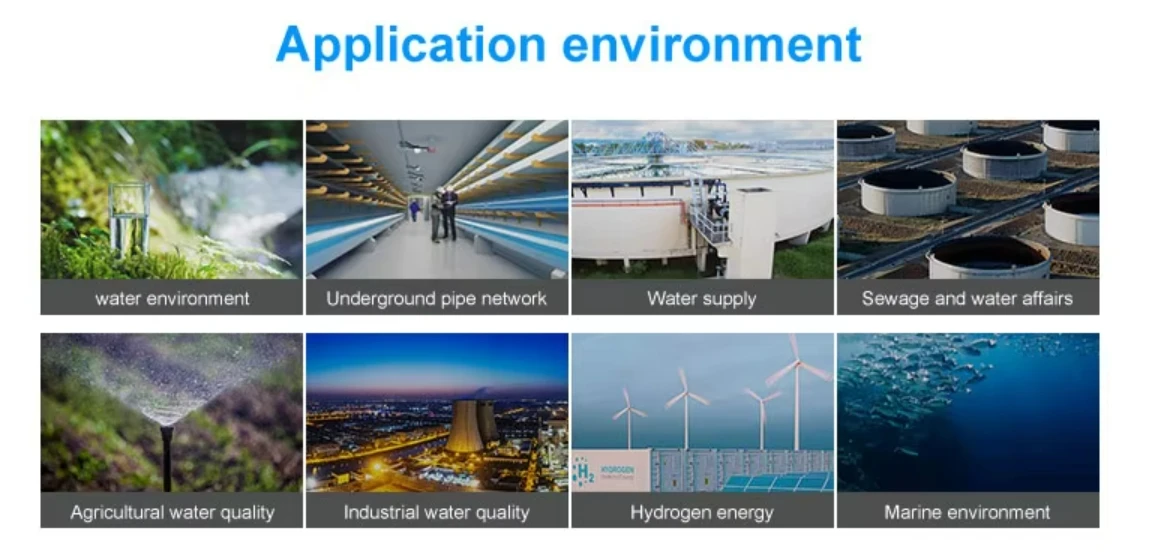| Availability: | |
|---|---|
◀◀ Key Selling Points ▶▶
Dissolved oxygen (DO) sensors are critical for measuring the amount of oxygen available in water, which is essential for aquatic life, industrial processes, and environmental protection. Below are the key application scenarios for DO sensors:
*Without electrolyte, the polarization will not
*Without consuming oxygen, without affecting the flow rate
*Built-in temperature sensor, automatic temperature compensation
*Interference is not sulfide and other chemicals
*Drift is small, fast response, more accurate measurement
*Maintenance-free, long life cycle, the use of lower cost
*Fluorescent cap replacement is simple
*RS-485 interface, Modbus-RTU protocol
◀◀ Product Parameters ▶▶
| Parameter Category | Specifications |
|---|---|
| Model | BGT-WDO(K2) |
| Housing Material | - POM, ABS/PC Alloy - TC4 Titanium Alloy - 316L Stainless Steel |
| Measurement Principle | Fluorescence Method |
| Measuring Range & Resolution | - 0~20.00 mg/L (0~200% Saturation, 25℃); Resolution: 0.01mg/L, 0.1℃ - 0~50.00 mg/L (0~500% Saturation, 25℃); Resolution: 0.01mg/L, 0.1℃ |
| Accuracy | ±2% (for dissolved oxygen), ±0.3℃ (for temperature) |
| Response Time (T90) | <30s |
| Minimum Detection Limit | 0.08mg/L |
| Calibration Method | Two-Point Calibration |
| Cleaning Method | / |
| Temperature Compensation | Automatic Temperature Compensation (Pt1000 Sensor) |
| Output Mode | RS-485 (Modbus RTU), 4-20 mA (Optional) |
| Storage Temperature | -5~65℃ |
| Operating Conditions | Temperature: 0~50℃; Pressure: ≤0.2MPa |
| Installation Method | Submersible Installation, 3/4 NPT |
| Power Consumption | 0.2W @ 12V DC |
| Power Supply | 12~24V DC |
| Protection Level | IP68 |
| Fluorescent Membrane Life | 1 Year (Under Normal Operating Conditions) |
| Cable Length | 5 Meters; Other Lengths Available on Customization |
◀◀ Application Scenarios ▶▶
Rivers, Lakes, and Oceans
Assess water health and detect hypoxia (low oxygen) in ecosystems.
Monitor eutrophication (algal blooms) caused by excess nutrients.
Wetlands & Estuaries
Study oxygen fluctuations due to tides and organic decomposition.
Activated Sludge Processes
Optimize aeration in biological treatment to reduce energy costs.
Effluent Compliance
Ensure discharged water meets regulatory DO levels (e.g., >2 mg/L for fish survival).
Anaerobic Digestion
Monitor oxygen-free conditions for biogas production.
Ponds, Tanks, and Recirculating Systems (RAS)
Maintain safe DO levels (typically 5–6 mg/L for most fish).
Prevent fish kills due to oxygen depletion (e.g., at dawn).
Transport of Live Seafood
Ensure sufficient oxygen during shipping.
Reservoirs & Pipelines
Detect oxygen levels to prevent corrosion (low DO) or taste issues (high DO).
Groundwater Monitoring
Track DO to assess contamination risks (e.g., methane intrusion).
Biotech & Fermentation
Control oxygen for microbial growth (e.g., in breweries, pharmaceuticals).
Power Plant Cooling Water
Prevent corrosion in boilers and condensers.
Pulp & Paper Industry
Monitor oxygen in effluent to comply with environmental regulations.
Oceanography & Limnology
Study seasonal DO variations in deep waters ("dead zones").
Laboratory Experiments
Test BOD (Biochemical Oxygen Demand) for pollution studies.
